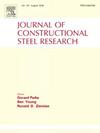Cyclic behavior of composite beam–steel column joints with peripheral laminated slabs
IF 4
2区 工程技术
Q1 CONSTRUCTION & BUILDING TECHNOLOGY
引用次数: 0
Abstract
This study introduces a novel laminated flooring system featuring narrow wet joints for frame connectivity, which significantly improves the assembly efficiency. Cyclic loading tests on four composite joint specimens were conducted to systematically evaluate the effects of width and material type of wet joints on the seismic performance. The results revealed that the specimens with C35 wet joints exhibited comparable seismic behavior to that with cast-in-situ slabs, with less than 5 % deviation in energy dissipation, load-bearing capacity, and stiffness degradation, attributed to similar crack propagation and consistent failure modes (concrete crushing around columns). Besides, the mechanical performance of composite joints was insensitive to the width of wet joints. The low damage characteristic of ultra-high-performance concrete (UHPC) wet joints reduced the energy dissipation capacity of the composite joint by about 16 %, but the well-maintained interaction between UHPC and columns significantly improved the secant stiffness by over 40 % and load-bearing capacity by 29.20 % at peak state. Moreover, strain-based analysis quantified the development of effective flange width at composite beam ends, and the calculated load-bearing capacity highlighted the tensile contribution of UHPC. Finally, the refined finite element model revealed the effect of experimental parameters on the deformation characteristics of five critical components governing the overall deformation of composite joints. The proposed system provides an innovative solution for industrialized development of prefabricated floor systems while offering new perspectives for enhancing seismic performance of composite joints through UHPC applications.
周边叠合板组合梁-钢柱节点的循环性能
本研究介绍了一种新型的层压地板系统,该系统具有用于框架连接的窄湿接缝,可显着提高装配效率。为系统评价湿缝宽度和材料类型对湿缝抗震性能的影响,对4个湿缝试件进行了循环加载试验。结果表明,C35湿缝试件与现浇板试件表现出相当的抗震性能,由于相似的裂缝扩展和一致的破坏模式(柱周围混凝土破碎),C35湿缝试件在能量耗散、承载能力和刚度退化方面的偏差小于5%。此外,湿缝宽度对复合接头的力学性能不敏感。超高性能混凝土(UHPC)湿节点的低损伤特性使复合节点的耗能能力降低了约16%,但保持良好的UHPC与柱的相互作用显著提高了峰值状态下的割线刚度40%以上,承载能力提高了29.20%。此外,基于应变的分析量化了组合梁两端有效翼缘宽度的发展,计算的承载能力突出了UHPC的拉伸贡献。最后,通过精细化有限元模型揭示了试验参数对复合材料接头整体变形的5个关键部件变形特性的影响。该系统为预制楼板系统的工业化发展提供了一种创新的解决方案,同时为通过UHPC应用提高复合接缝的抗震性能提供了新的视角。
本文章由计算机程序翻译,如有差异,请以英文原文为准。
求助全文
约1分钟内获得全文
求助全文
来源期刊

Journal of Constructional Steel Research
工程技术-工程:土木
CiteScore
7.90
自引率
19.50%
发文量
550
审稿时长
46 days
期刊介绍:
The Journal of Constructional Steel Research provides an international forum for the presentation and discussion of the latest developments in structural steel research and their applications. It is aimed not only at researchers but also at those likely to be most affected by research results, i.e. designers and fabricators. Original papers of a high standard dealing with all aspects of steel research including theoretical and experimental research on elements, assemblages, connection and material properties are considered for publication.
 求助内容:
求助内容: 应助结果提醒方式:
应助结果提醒方式:


